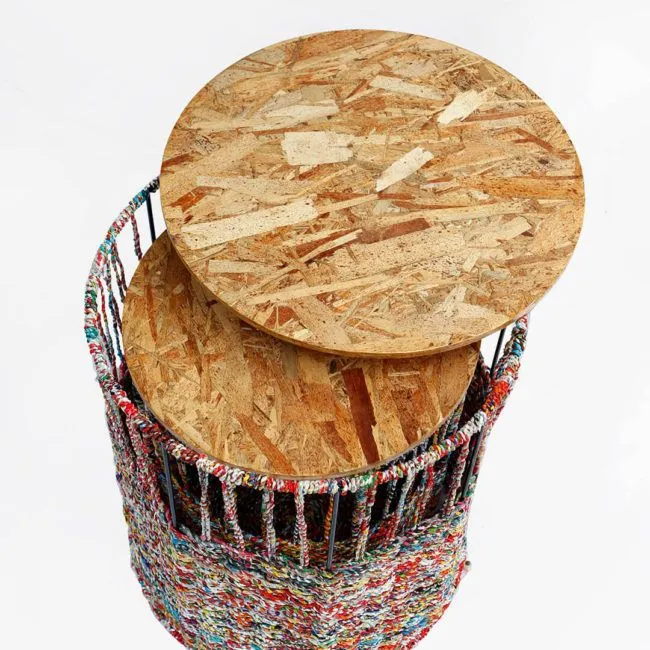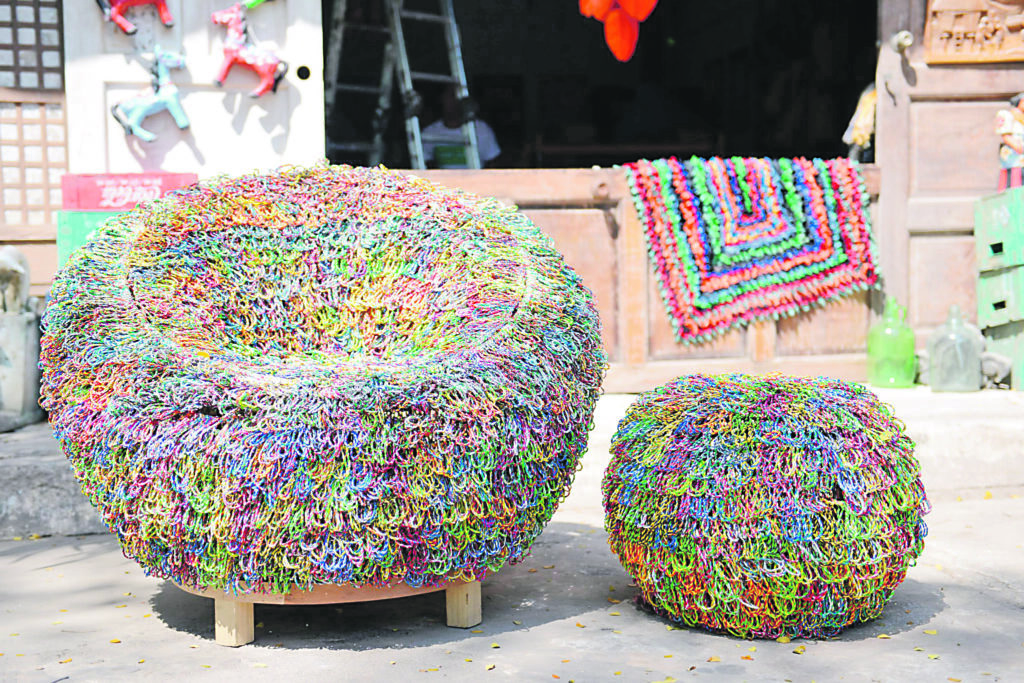At the heart of the interior design company is a women’s group called Junk Not, which operates on a sustainable principle.
“There is no such thing as waste, only resources out of place.”

An interior designer and environmentalist, Willie Garcia founded Junk Not in 2009 to address waste management by upcycling plastic waste into home furnishings and décor. It also provided livelihood to those displaced by the 2020 Taal Volcano eruption.

“Always consider the social and environmental impact of materials used in design. It feels good to design something that has a great story behind it. Designing with purpose means selecting materials that uphold ethical and sustainable practices, support communities, and reduce environmental harm. Designing with intentionality adds depth and significance to creations,” Garcia told DAILY TRIBUNE.

Pursuing creative interests
After graduating college, Garcia was employed as a Visual Merchandising Artist at Hallmark Cards and Burlington Socks for a year. However, she decided to resign from her position to care for her mother, who had been dialyzed for 17 years, and her dad for two years. Despite this transition, Garcia remained dedicated to her passion for arts and commitment to the environment by freelancing as an interior designer.

“This allowed me to pursue my creative interests while fulfilling my responsibilities at home, ensuring a balance between personal and professional pursuits,” she said.
First project
Her first project as a freelance interior designer was a resthouse in Tagaytay, a referral from her brother.
She said, “I approached this project with a unique perspective, advocating against purchasing new items and encouraging the client to repurpose existing items within their home. This approach posed a challenge but also allowed for a creative and sustainable solution that aligned with my values of minimizing waste and maximizing resourcefulness. By carefully selecting and repurposing existing items, we transformed the space into a harmonious and eco-friendly environment that reflected the client’s vision while minimizing environmental impact.”
Garcia graduated from St. Scholastica’s College Manila in 2020 with a Bachelor of Fine Arts Major in Interior Design. In 2010, she was one of the delegates in the “Youth Encounter in Sustainability,” a two-week course in Armenia, Colombia.

In 2014, Garcia was selected as one of the ten female international Artists to participate in the Artisan Residency in Sefrou, Morocco, with the support of NCCA and Metrobank Foundation 2021 Degree in Master in Entrepreneurship program in Social Enterprise Development Track (MESEDEV) Ateneo Graduate School of Business.
“While each artist pursued their respective disciplines, I joined this program to learn leather craft for my bag designs. However, upon witnessing the treatment of animals within the leather industry in Morocco, I was deeply disappointed, and so SAD I got sick, seeing all the beheaded animals in the oldest tannery in the world. I decided to redirect my focus towards addressing waste management issues,” she said.
A sense of purpose
Collaborating with the local youth center and the Peace Corps, Garcia organized a river cleanup initiative in Sefrou. She audited the collected materials and turned them into chairs.
“This experience ignited a sense of purpose within me, sparking a commitment to promoting environmental stewardship wherever I go. Inspired by the twining techniques observed during the residency, I began to explore ways to incorporate this method into my designs using only hand labor. This marked the beginning of a journey defining my career, as I sought to innovate sustainable practices and elevate waste management solutions in my creative endeavors. I could do the entire stool process by myself for four days,” Garcia recalled.
Last year, McDonald’s partnered with Junk Not to embark on a meaningful local undertaking called ReClassified Classrooms. This initiative saw the upcycling of the fast food giant’s decommissioned store furnishings to produce durable school armchairs and tables for the benefit of schools and institutions that most need them. An early beneficiary was a school in Marikina City.
“This is another unique project through our TIE-UP program that involves transforming old chairs and tables from McDonald’s into school desk chairs. These refurbished pieces are then generously donated to various public schools, providing students with much-needed seating. It’s a remarkable initiative that repurposes materials and contributes to improving educational environments for children in need,” Garcia said.

The beginning of Junk Not
As Junk Not was officially registered as a sole proprietorship with the DTI, Garcia embarked on a journey of green interior design services and fashion accessories crafted from plastic waste. In 2013, she ventured into furniture design, experimenting with twined plastic waste, initially implementing the concept in her brother’s restaurant, Balik Bukid, located in Davao.
Over time, Garcia refined the process and in 2015, with the support of the DENR-TVPL project, she extended this initiative to the broader community.
Today, Junk Not processes 3.5 metric tons of plastic waste. Expanding its scope, the social enterprise now produces trophies and corporate giveaways for companies through its TIE-UP program (Trash innovation in exchange for Upcycling), facilitating corporate social responsibility initiatives.
“As the founder of Junk Not, my journey began in 2007 when I established my furniture shop after winning the MADE Metrobank Arts and Design Excellence competition. With the prize money of P250,000, I invested in second-hand machinery for my shop, laying the foundation for what Junk Not has become today. Over the years, we’ve expanded to include various departments such as administration, carpentry, painting, weaving, and our invaluable community partnership. Together, we continue to innovate and create sustainable solutions, driven by our passion for environmental conservation and social impact,” she said.

Garcia conceptualizes all Junk Not’s designs, oversees its frame fabrication, and personally crafts weaving prototypes before teaching the technique to her team.
“Through a unique partnership with the community, we empower individuals by teaching proper waste management. This approach transforms recyclables into twined materials. As a result, community members have ceased improper waste disposal practices, instead expanding their collection efforts to neighbors and local stores. Junk Not’s impact extends beyond artistry — it’s about transforming lives and environments through sustainable practices,” she said.
Junk Not’s notable projects include the UAAP season 82 trophy and medal, ECCK trophies, Euro Chamber Commerce Singapore and ESG award in Singapore, furniture supply for Uniqlo, and Google and Lazada offices.
“Junk Not aspires to collaborate with various companies to integrate circular economy principles into their operations. By partnering with businesses, we aim to explore innovative ways to reduce waste, reuse materials, and promote sustainable practices throughout their processes. Through this collaboration, we can collectively create a more circular economy, where resources are utilized efficiently, waste is minimized, and environmental impact is reduced. Together, we can pave the way for a more sustainable future,” Garcia added.
Holistic approach
Sustainability will always be at the heart of what Garcia does.
“For me, green design maximizes the use of available materials within the project area. This includes sourcing reclaimed items that we can refurbish, reuse, recycle, and upcycle; incorporating indigenous materials found within the local environment, and utilizing non-toxic materials for interior applications,” Garcia said.
By prioritizing sustainability in this way, the ecological footprint is decreased while healthier living spaces are created for occupants.
“This holistic approach to design ensures that every aspect of the project is mindful of its environmental impact, contributing to a more sustainable and resilient future,” she concluded.
